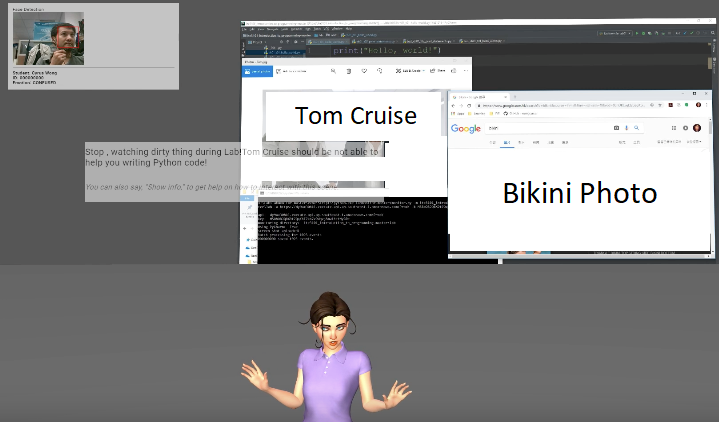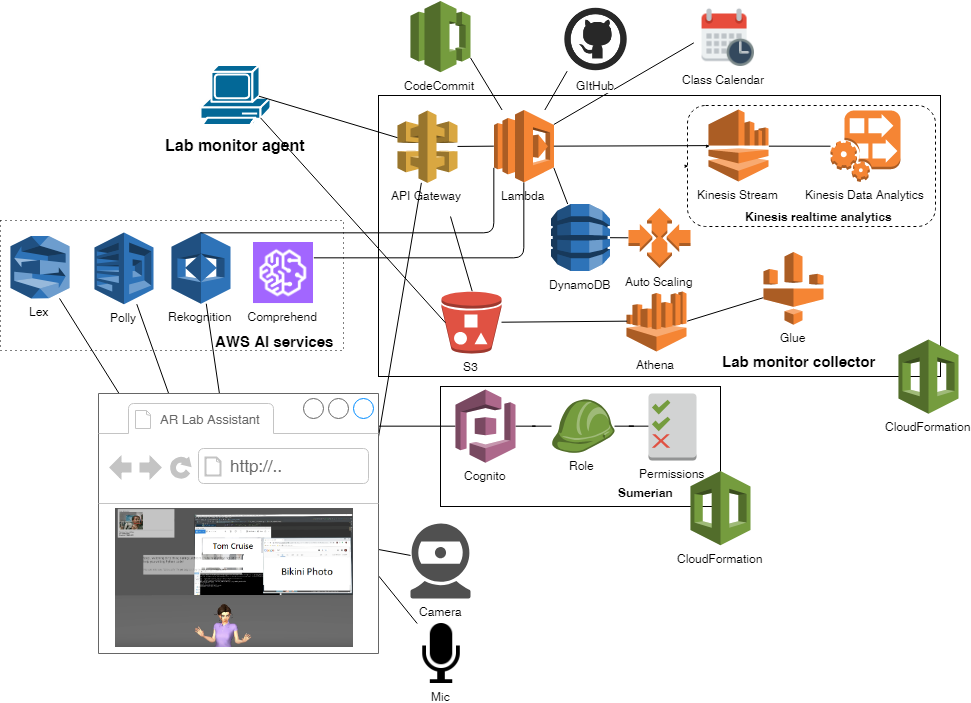Using AWS AI and Amazon Sumerian in IT Education
This guest post is by AWS Machine Learning Hero, Cyrus Wong. Cyrus is a Data Scientist at the Hong Kong Institute of Vocational Education (Lee Wai Lee) Cloud Innovation Centre. He has achieved all nine AWS Certifications and enjoys sharing his AWS knowledge with others through open-source projects, blog posts, and events.
Our institution (IVE) provides IT training to several thousand students every year and one of our courses successfully applied AWS Promotional Credits. We recently built an open-source project called “Lab Monitor,” which uses AWS AI, serverless, and AR/VR services to enhance our learning experience and gather data to understand what students are doing during labs.
Problem
One of the common problems of lab activity is that students are often doing things that have nothing to do with the course (such as watching videos or playing games). And students can easily copy answers from their classmate because the lab answers are in softcopy. Teachers struggle to challenge students as there is only one answer in general. No one knows which students are working on the lab or which are copying from one another!
Solution
Lab Monitor changes the assessment model from just the final result to the entire development process. We can support and monitor students using AWS AI services.
The system consists of the following parts:
- A lab monitor agent
- A lab monitor collector
- An AR lab assistant
Lab monitor agent
The Lab monitor agent is a Python application that runs on a student’s computer activities. All information is periodically sent to AWS. To identify students and protect the API gateway, each student has a unique API key with a usage limit. The function includes:
- Capturing all keyboard and pointer events. This can ensure that students are really working on the exercise as it is impossible to complete a coding task without using keyboard and pointer! Also, we encourage students to use shortcuts and we need that information as indicator.
- Monitoring and controlling PC processes. Teachers can stop students from running programs that are irrelevant to the lab. For computer test, we can kill all browsers and communication software. Processing detailed information is important to decide to upgrade hardware or not!
- Capturing screens. Amazon Rekognition can detect video or inappropriate content. Extracted text content can trigger an Amazon Sumerian host to talk to a student automatically. It is impossible for a teacher to monitor all student screens! We use a presigned URL with S3 Transfer Acceleration to speed up the image upload.
- Uploading source code to AWS when students save their code. It is good to know when students complete tasks and to give support to those students who are slower!
Lab monitor collector
The Lab monitor collector is an AWS Serverless Application Model that collects data and provides an API to AR Lab Assistant. Optionally, a teacher can grade students immediately every time they save code by running the unit test inside AWS Lambda. It constantly saves all data into an Amazon S3 data lake and teachers can use Amazon Athena to analyze the data.
To save costs, a scheduled Lambda function checks the teacher’s class calendar every 15 minutes. When there is an upcoming class, it creates a Kinesis stream and Kinesis data analytics application automatically. Teachers can have a nearly real-time view of all student activity.

AR Lab Assistant
The AR lab assistant is a Amazon Sumerian application that reminds students to work on their lab exercise. It sends a camera image to Amazon Rekognition and gets back a student ID.
A Sumerian host, Christine, uses Amazon Polly to speak to students with when something happens:
- When students pass a unit test, she says congratulations.
- When students watch movies, she scolds them with the movie actor’s name, such as Tom Cruise.
- When students watch porn, she scolds them.
- When students do something wrong, such as forgetting to set up the Python interpreter, she reminds them to set it up.
Students can also ask her questions, for example, checking their overall progress. The host can connect to a Lex chatbot. Student’s conversations are saved in DynamoDB with the sentiment analysis result provided by Amazon Comprehend.
The student screen is like a projector inside the Sumerian application.

Christine: “Stop, watching dirty thing during Lab! Tom Cruise should not be able to help you writing Python code!”
Simplified Architectural Diagrams

Demo video
AR Lab Assistant reaction: https://youtu.be/YZCR2aROBp4
Conclusion
With the combined power of various AWS services, students can now concentrate on only their lab exercise and stop thinking about copying answers from each other! We built the project in about four months and it is still evolving. In a future version, we plan to build a machine learning model to predict the students’ final grade based on their class behavior. They feel that the class is much more fun with Christine.
Lastly, we would like to say thank you to AWS Educate, who provided us with AWS credit, and my AWS Academy student developer team: Mike, Long, Mandy, Tung, Jacqueline, and Hin from IVE Higher Diploma in Cloud and Data Centre Administration. They submitted this application to the AWS Artificial Intelligence (AI) Hackathon and just learned that they received a 3rd place prize!
Source: AWS News


